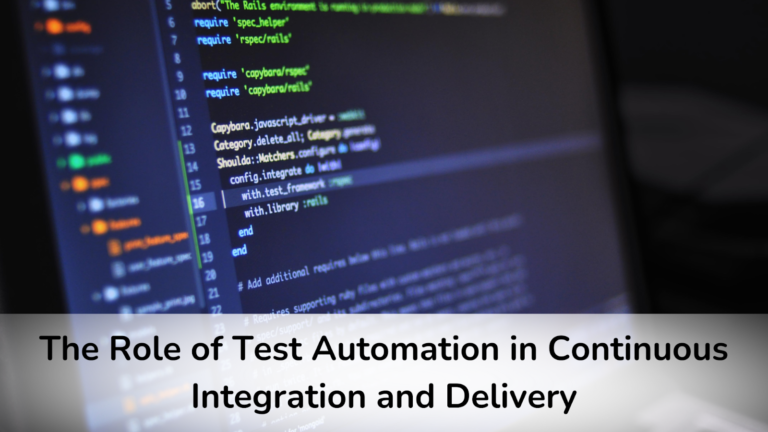Why is software development becoming more complex? As applications expand in size and complexity, maintaining quality while ensuring rapid delivery presents significant challenges. This is where test automation in Continuous Integration and Delivery (CI/CD) becomes essential.
By automating repetitive testing tasks, development teams can catch bugs earlier, improve software quality, and accelerate the delivery process. This article explores the role of test automation in CI/CD, its implementation, and its impact on the challenges of modern software development.
What is Continuous Integration and Continuous Delivery?
Before diving into the role of automation testing, it’s important to understand what CI/CD is and why it matters.
Continuous Integration involves frequently merging code changes into a central repository, after which automated builds and tests are run. The primary goal of CI is to quickly find and address bugs, improve software quality, and reduce the time needed to validate and release new software updates.
Continuous Delivery extends CI by automatically deploying all code changes to testing or production environments after the build stage. This allows teams to release new features to customers quickly and frequently.
The Importance of Test Automation in CI/CD
Test automation is essential in making CI/CD possible and effective. Automated tests can be run quickly and repeatedly, allowing for faster feedback on code changes. This speed is essential in CI/CD pipelines, where code is integrated and deployed frequently.
Unlike manual testing, automated tests perform the same operations each time they run, eliminating human error and providing consistent results. For teams looking to streamline their testing processes, testRigor provides a powerful solution by enabling non-technical team members to create and maintain tests using plain English.
This approach accelerates the testing process, allowing teams to run a wider variety of tests in less time, increasing overall test coverage and improving software quality. By automatically running tests with each code change, bugs are caught earlier in the development process, making them easier and less expensive to fix.
| Aspect | Manual Testing | Automated Testing |
| Speed | Slow | Fast |
| Consistency | Variable | Highly consistent |
| Cost | High long-term cost | High initial cost, lower long-term cost |
| Coverage | Limited by time and resources | Can cover a wide range of scenarios |
| Flexibility | Adaptable to changes | Requires maintenance when the application changes |
| Human insight | High | Limited |
Types of Test Automation in CI/CD
Different types of automated tests play various roles in the CI/CD pipeline. Let’s explore the most common types:
Unit Tests
Unit tests verify the functionality of individual components or functions in isolation. They are typically written and run by developers as part of the development process. Unit tests offer fast execution, early bug detection, improved code quality, and easier refactoring.
Integration Tests
Integration tests verify that different components or services work together correctly. They are crucial in ensuring that changes in one part of the system don’t disrupt functionality in another. Integration tests help catch interface issues between components, verify system behavior, and identify performance bottlenecks.
Functional Tests
Functional tests verify that the system behaves as expected from an end-user perspective. These tests often simulate user interactions with the application. They ensure user requirements are met, catch regressions in user-facing features, and provide confidence for deployment decisions.
Performance Tests
Performance tests evaluate the system’s responsiveness and stability under various load conditions. They are crucial for ensuring that new changes don’t negatively impact system performance. Performance tests help identify performance regressions early, ensure the scalability of the system, and validate system behavior under stress.
Implementing Test Automation in CI/CD
Implementing automation testing in a CI/CD pipeline requires careful planning and execution. Selecting appropriate automation tools is crucial for successful implementation. Consider factors such as programming language support, integration with existing CI/CD tools, ease of use and maintenance, and community support and documentation.
A well-planned test strategy ensures that your automated tests provide maximum value. Consider the test pyramid approach (more unit tests, fewer UI tests), risk-based testing to prioritize critical areas, and balancing the speed and thoroughness of tests.
Automated tests should be treated with the same care as production code. Follow best practices such as using design patterns (e.g., Page Object Model for UI tests), keeping tests independent and atomic, and implementing proper error handling and logging.
Incorporate automated tests at various stages of your CI/CD pipeline. Run unit and integration tests on every commit, functional tests before deploying to staging, and performance tests on a regular schedule or before major releases.
Establish a process for addressing test failures in the CI/CD pipeline:
- Automatically notify relevant team members
- Prioritize fixing failing tests
- Implement quarantine mechanisms for flaky tests
Challenges and Best Practices
Test automation in CI/CD faces challenges such as flaky tests that produce inconsistent results, increased test execution time as the number of tests grows, and the need for continuous test code maintenance as the application evolves. Addressing these issues requires careful management to ensure the CI/CD pipeline remains efficient and reliable.
Here are the best practices to address the challenges:
Quarantine and Fix Flaky Tests: Identify, quarantine, and address the root causes. Parallelize and Prioritize Tests: Use parallel execution, test segmentation, and prioritization. Utilize Cloud-Based Infrastructure: Leverage scalable cloud testing environments. Maintain Test Code Quality: Treat test code like production code with reviews and refactoring. Enhance Test Accuracy: Regularly update assertions, implement comprehensive logging, and periodically verify critical tests manually. |
Measuring the Success of Test Automation in CI/CD
To ensure that your test automation efforts are effective, it’s important to measure and monitor key metrics. Monitor the percentage of code covered by automated tests. While 100% coverage isn’t always necessary or practical, tracking this metric can help identify areas that need more testing.
Keep an eye on how long it takes to run your automated test suite. As your application grows, you may need to optimize tests or infrastructure to maintain fast feedback cycles. Track the number of bugs that make it to production despite automated testing. A decreasing trend in this metric indicates improving test effectiveness.
Track how often you’re able to deploy to production. Effective test automation should enable more frequent, confident deployments. Measure how quickly you can identify and fix issues in production. Robust automated testing should help reduce this time by catching more issues before they reach production.
Conclusion
In CI/CD, automated testing is essential. It helps software engineers deliver high-quality software quickly. Improved test automation allows you to find bugs sooner. It allows for more frequent releases and happy customers. But despite these challenges, the advantages greatly surpass any costs incurred. Therefore, to improve your software quality and delivery speed, add test automation to your CI/CD pipeline.
Frequently Asked Questions
How do we handle test data in automated tests?
Use a combination of static test data, data generation tools, and mock objects. Ensure test data is representative, maintainable, and does not expose sensitive information.
What’s the role of artificial intelligence in test automation?
AI can help prioritize tests, generate test cases, analyze test results, and predict potential issues. It’s an emerging field that can enhance traditional test automation approaches.
How do we ensure our test automation strategy aligns with business goals?
Collaborate with stakeholders to identify critical business processes. Prioritize automating tests for these areas and align test metrics with key performance indicators (KPIs).





